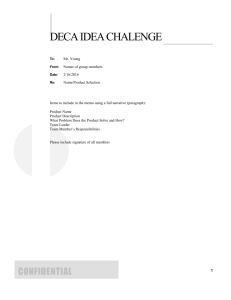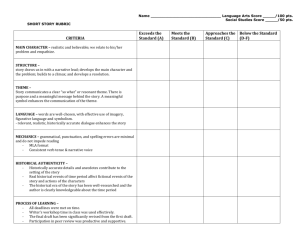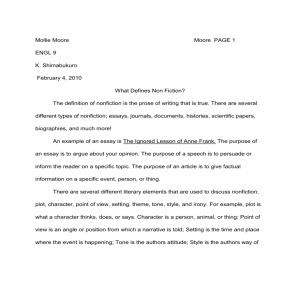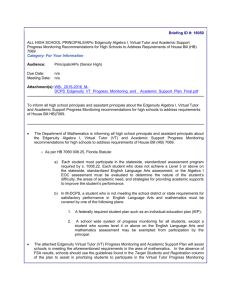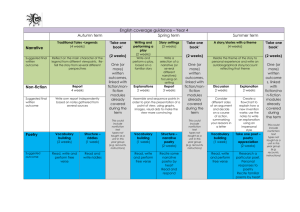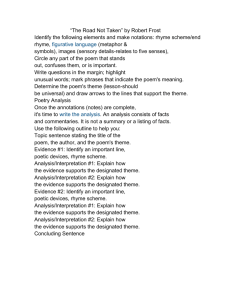ELA 7 Scope and Sequence: Identity, Narrative, Analysis
advertisement
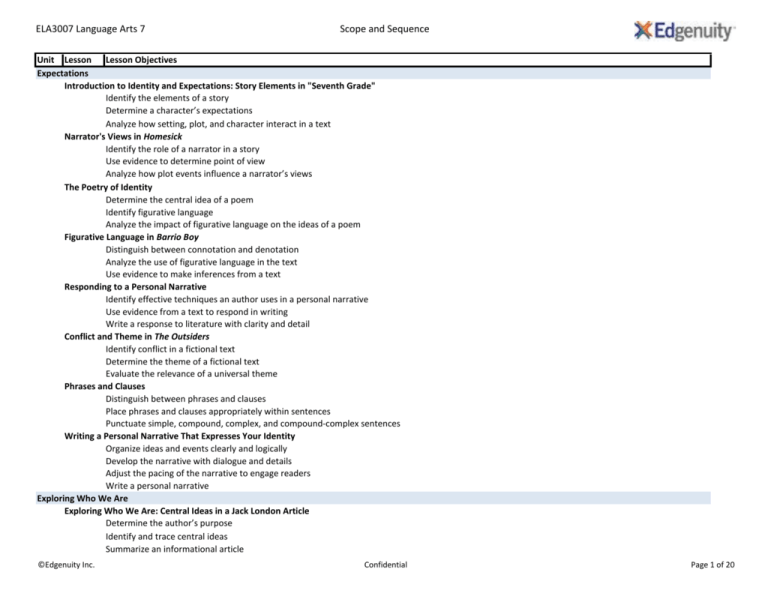
ELA3007 Language Arts 7 Scope and Sequence Unit Lesson Lesson Objectives Expectations Introduction to Identity and Expectations: Story Elements in "Seventh Grade" Identify the elements of a story Determine a character’s expectations Analyze how setting, plot, and character interact in a text Narrator's Views in Homesick Identify the role of a narrator in a story Use evidence to determine point of view Analyze how plot events influence a narrator’s views The Poetry of Identity Determine the central idea of a poem Identify figurative language Analyze the impact of figurative language on the ideas of a poem Figurative Language in Barrio Boy Distinguish between connotation and denotation Analyze the use of figurative language in the text Use evidence to make inferences from a text Responding to a Personal Narrative Identify effective techniques an author uses in a personal narrative Use evidence from a text to respond in writing Write a response to literature with clarity and detail Conflict and Theme in The Outsiders Identify conflict in a fictional text Determine the theme of a fictional text Evaluate the relevance of a universal theme Phrases and Clauses Distinguish between phrases and clauses Place phrases and clauses appropriately within sentences Punctuate simple, compound, complex, and compound-complex sentences Writing a Personal Narrative That Expresses Your Identity Organize ideas and events clearly and logically Develop the narrative with dialogue and details Adjust the pacing of the narrative to engage readers Write a personal narrative Exploring Who We Are Exploring Who We Are: Central Ideas in a Jack London Article Determine the author’s purpose Identify and trace central ideas Summarize an informational article ©Edgenuity Inc. Confidential Page 1 of 20 ELA3007 Language Arts 7 Scope and Sequence Unit Lesson Lesson Objectives Point of View in White Fang Identify point of view in a fictional text Contrast the perspective of different characters Analyze the role of point of view in a fictional text Character Development in White Fang Identify techniques the author uses to develop characters in a text Analyze how story elements interact Trace character development Writing an Analysis of Characterization Compose a written character analysis Organize ideas prior to writing using a graphic organizer Provide textual evidence to support analysis Conflict in White Fang Identify types of conflict in a piece of fiction Analyze story elements that create conflict Make, confirm, and revise predictions Theme in White Fang Identify character motivations Identify theme Create a theme statement Parts of Speech and Modifiers Identify the six basic parts of speech Place modifiers correctly within a sentence Identify and correct misplaced and dangling modifiers Writing an Informative Essay about an Exciting Tradition Research from credible sources Organize concepts and ideas using a graphic organizer Revise to include relevant facts and details Write an informative essay with interesting details Heritage Heritage: Japanese Culture in a Folktale Define the genres of myth and folktale Determine how myths and folktales connect to places and people Explore how myths and folktales use elements of nonfiction Rhyme, Rhythm, and Visualizing in a Yeats Poem Visualize to imagine a complex poem Examine the rhyme scheme and rhythm in a poem ©Edgenuity Inc. Confidential Page 2 of 20 ELA3007 Language Arts 7 Unit Lesson ©Edgenuity Inc. Scope and Sequence Lesson Objectives Analyze the effect of rhyme and rhythm on a poem Confidential Page 3 of 20 ELA3007 Language Arts 7 Scope and Sequence Unit Lesson Lesson Objectives Influences and Inferences in "Names/Nombres" Analyze influences that shape an author Make and support inferences using evidence from the text Determine the theme of an essay Setting and Character in Dragonwings Identify how a specific setting, or the time and place of a story, advances the plot Make inferences about a character based on his or her behavior Compare and contrast a story and a primary source that depict similar events Comparing and Contrasting Genres Organize ideas prior to writing by using a graphic organizer Create effective transitions to connect points of comparison Write a paragraph that compares and contrasts the benefits of two genres Structure and Culture in "Twelfth Song of the Thunder" -ADD "Structure" and "the" Analyze the impact of repetition in poetry Use historical interpretations to strengthen your understanding of a poem Explore how elements of Navajo culture are reflected in their poetry Word Meanings Determine word meaning using Greek and Latin affixes and roots Use Greek and Latin affixes and roots to define common academic words Verify preliminary definitions by using a dictionary Creating a Yearbook Page Research and collect text evidence about a person from a text Organize information Use multimedia components to describe a person from a text Create a yearbook page that expresses the characteristics of a person Focusing on an Objective Perseverance and Focusing on an Objective: Viewpoint in The Riddle of the Rosetta Stone Identify an author's viewpoint in an informational text Distinguish the author's views from those of others Differentiate fact from opinion Cause and Effect in The Riddle of the Rosetta Stone Identify causal relationships Cite textual details as evidence Sequence events to explain cause and effect Characterization in The Riddle of the Rosetta Stone Analyze the characterization of a historical figure ©Edgenuity Inc. Confidential Page 4 of 20 ELA3007 Language Arts 7 Unit Lesson ©Edgenuity Inc. Scope and Sequence Lesson Objectives Determine the author’s attitude toward a subject Identify examples of bias in an informational text Confidential Page 5 of 20 ELA3007 Language Arts 7 Unit Scope and Sequence Lesson Lesson Objectives Influences on Ideas in The Riddle of the Rosetta Stone Analyze the influence of individuals on other individuals within the text Compare and contrast individuals within the same text Make predictions about a nonfiction text Reasoning and Logic in The Riddle of the Rosetta Stone Recognize an argument’s use of logic Identify the big picture and specific details to understand a text Draw conclusions Context Clues and Inferences in The Riddle of the Rosetta Stone Determine causes and effects to understand a text Determine the meaning of technical language Make an inference about the message of a nonfiction text Central Ideas and Purpose in The Riddle of the Rosetta Stone Identify central ideas Trace the development of central ideas Summarize the purpose of a text Writing an Analysis of a Nonfiction Text Use text evidence to identify a thesis Revise to support conclusions with relevant information Write an analysis using appropriate evidence and reflection Pursuing the Dream Pursuing the Dream as a Central Idea in Poetry Identify figurative language Determine the central idea of a poem Compare the messages of two different poems Making Inferences in an Article about Roberto Clemente Distinguish sequences of events Make inferences using supporting details Explore multiple sources for information Summarizing a Text by Jackie Robinson Identify central ideas and supporting details Summarize a text Determine an author’s purpose for writing Writing a Narrative: Describing a Problem Organize ideas for a narrative Establish a point of view ©Edgenuity Inc. Confidential Page 6 of 20 ELA3007 Language Arts 7 Unit Lesson ©Edgenuity Inc. Scope and Sequence Lesson Objectives Use techniques that paint pictures for the reader Write a personal narrative describing a problem Confidential Page 7 of 20 ELA3007 Language Arts 7 Scope and Sequence Unit Lesson Lesson Objectives Drawing Conclusions in a Cesar Chavez Speech Recognize elements of persuasion in a speech Draw conclusions about an author’s purpose Connect details to theme Central Ideas in We Beat the Street Identify central ideas and supporting details Determine cause-and-effect relationships Compare and contrast to analyze change Word Relationships: Using Context Understand the importance of context Use context clues to determine meaning Recognize the difference between connotation and denotation Use context to understand the author’s meaning Writing an Argument that Supports the Characteristics of a Role Model Develop a claim, reasoning, and evidence to make an argument Organize reason and evidence logically Revise to use precise language Write an argument with a well-supported concluding statement Overcoming the Odds Overcoming the Odds: The Miracle Worker, Act I Identify the elements of a drama Analyze characterization in a play Summarize the central idea of a scene Elements of Drama in The Miracle Worker , Acts II and III Identify how information is communicated through dialogue Examine the role of setting in a play Analyze how stage directions contribute to the meaning of a play Point of View in Helen Keller's Memoir, The Story of My Life Analyze the impact of imagery in a selection Identify an author’s point of view Compare the way two authors cover the same information Writing with Credible Sources Evaluate the credibility of a source Summarize information from multiple sources Cite a source correctly Word Choice and Structure in "The Turtle" ©Edgenuity Inc. Confidential Page 8 of 20 ELA3007 Language Arts 7 Unit Lesson ©Edgenuity Inc. Scope and Sequence Lesson Objectives Examine the elements of poetry Analyze the effect of word choice in a poem Determine the theme of a poem Confidential Page 9 of 20 ELA3007 Language Arts 7 Scope and Sequence Unit Lesson Lesson Objectives Conflict and Resolution in "Amigo Brothers" Recognize elements of plot structure Examine conflict’s role in a story Determine the theme of a story Group Discussion Prepare to participate in a formal group discussion Recognize and apply guidelines for listening and speaking in a group Demonstrate the ability to present and respond to information in a formal discussion Creating a Text Trailer Research to gather and organize ideas about conflicts in a text Create a multimedia text trailer that shows tension and entices viewers to read Analyze the appropriate tone for a project Neighbors Neighbors: Visualizing in The Monsters Are Due on Maple Street Identify the elements of a drama Recognize how a drama reveals characters’ perspectives Visualize scenes from a drama Graphic Novels and The Monsters Are Due on Maple Street Compare different methods of storytelling Make predictions from visual and textual clues Identify and cite examples of foreshadowing Theme in The Monsters Are Due on Maple Street Define the science fiction genre Examine the role of stage directions Determine theme in a drama Character Relationships in Walter Dean Myers’s "The Treasure of Lemon Brown" Examine how an author creates characters Evaluate characters through dialogue and action Interpret changes in relationships between characters Using Dialogue Effectively Identify the elements of a narrative Understand the importance of dialogue Follow the conventions of punctuation in dialogue Narrative Elements in "How I Learned English" Analyze first-person point of view Understand elements of narrative poetry ©Edgenuity Inc. Confidential Page 10 of 20 ELA3007 Language Arts 7 Unit Scope and Sequence Lesson Lesson Objectives Visualize imagery in a poem Capitals and Commas Identify and apply capitalization rules Identify and apply comma rules Edit a text to assess proper use of commas and capitalization ©Edgenuity Inc. Confidential Page 11 of 20 ELA3007 Language Arts 7 Scope and Sequence Unit Lesson Lesson Objectives Writing an Analysis of a Literary Character Choose strong text evidence to plan a compare-and-contrast analysis Revise to clarify ideas and conclusions Write an analysis that shows clear changes in a character Freedom Fighters Freedom Fighters: Viewpoint in an Article about Malala Yousafzai Identify an author’s viewpoint Recognize the impact of setting in a text Investigate ideas presented in a digital format Setting in We’ve Got a Job Analyze how events and ideas interact Investigate history through personal accounts Evaluate how authors profile historical figures Reader Connections in We've Got a Job Identify types of reader connections Connect individuals to events Evaluate tone in an informational text Tone and Style in Online Writing Explore an online writing format Assess the use of tone in writing Make style choices based on audience Narrative Structure in We’ve Got a Job Examine narrative nonfiction Determine narrative voice Evaluate third-person narration Multiple Stories in We’ve Got a Job Examine multiple experiences of the same events Evaluate how the author integrates quotations Summarize the text Choosing Words Wisely Differentiate between synonyms and antonyms Use traditional reference material Select appropriate online resources Writing an Argumentive Essay about Education Research to gather appropriate information Organize concepts and ideas using a graphic organizer ©Edgenuity Inc. Confidential Page 12 of 20 ELA3007 Language Arts 7 Unit Lesson ©Edgenuity Inc. Scope and Sequence Lesson Objectives Revise to include relevant facts and details Write an argument that addresses claims and counterclaims Confidential Page 13 of 20 ELA3007 Language Arts 7 Scope and Sequence Unit Lesson Lesson Objectives Visions of the Past and Future Visions of the Past and Future: Structure in "I Hear America Singing" Evaluate the effect of repetition Examine free verse structure Interpret metaphors Combining Sources to Understand the Life of Abraham Lincoln Visualize a historical person by using primary and secondary sources Recognize humor in a text Support understanding of a text by using a web resource Persuasion in Susan B. Anthony’s "On Women’s Right to Vote" Assess the author’s tone Determine the purpose of a persuasive speech Recognize evidence in an argument Argumentation in "The Girl Who Silenced the World for Five Minutes" Evaluate the reasoning of an argument Distinguish fact from opinion Recognize the purpose of questioning Persuasion and Tone in a Speech Establish an appropriate tone Evaluate the effect of word choices on tone Compare and contrast in writing Central Ideas in Eleanor Roosevelt’s "What I Hope to Leave Behind" Determine central ideas in a nonfiction text Paraphrase central ideas Analyze the effect of historical context on the author’s purpose Word Relationships: Accurate and Interesting Words Recognize word relationships and nuanced meaning Distinguish shades of meaning among words Choose precise words Creating a Blog Explore the purpose of a blog Research a topic Develop a claim with research and evidence Create a blog using multimedia tools that enhance the argument and engage the readers Heroism Heroes of the People: Fact and Folktale in The People Could Fly ©Edgenuity Inc. Confidential Page 14 of 20 ELA3007 Language Arts 7 Unit Lesson ©Edgenuity Inc. Scope and Sequence Lesson Objectives Identify the features of a folktale Determine the role of setting in myth and folktale Analyze how fiction uses elements of nonfiction Confidential Page 15 of 20 ELA3007 Language Arts 7 Scope and Sequence Unit Lesson Lesson Objectives Personification in The People Could Fly Identify elements of a fable Determine the role of personification in a fable Examine why cultures create fables Characters in The People Could Fly Analyze characterization Recognize the plot's impact on characterization Setting and Dialect in The People Could Fly Visualize the setting of a fictional story Use context clues and in-text definitions to understand dialect Compare written text to an audio version Point of View and Viewpoint in The People Could Fly Identify point of view Interpret viewpoint Compare fiction to nonfiction Conflict and Theme in The People Could Fly Recognize plot elements Identify the antagonist and protagonist of a story Repetition in The People Could Fly Identify repetition in plot structure Analyze the role of suspense in a story Evaluate repetition's effect on climax and resolution Writing an Argumentative Essay about a Social Topic Brainstorm ideas and supporting examples Revise to address claims and counterclaims Write an argumentative essay with a strong concluding statement Battling Adversity Heroism and Battling Adversity: Structure in "The Charge of the Light Brigade" Examine rhythm in a poem Identify the effect of repetition in a poem Analyze the structure of a poem Cause and Effect in An American Plague Define cause and effect Determine causal relationships Trace central ideas in a text First-Person Point of View in Fever 1793 ©Edgenuity Inc. Confidential Page 16 of 20 ELA3007 Language Arts 7 Unit Lesson ©Edgenuity Inc. Scope and Sequence Lesson Objectives Analyze first-person point of view Examine the role of first-person point of view in engaging the reader Connect a literary text to historical events Confidential Page 17 of 20 ELA3007 Language Arts 7 Scope and Sequence Unit Lesson Lesson Objectives Writing a Comparison of Fiction and Nonfiction Compare and contrast elements of fiction and nonfiction Analyze characterization techniques used in historical fiction Organize writing by using effective transitions Characterization and Central Ideas in A Night to Remember Identify elements of historical nonfiction Examine characterization techniques in a nonfiction text Support central ideas with textual details Language and Purpose in Exploring the Titanic Determine the author’s purpose Examine the effect of tone Use context clues to understand technical jargon Choosing Precise Words to Eliminate Wordiness and Redundancy Analyze the importance of word choice Make thoughtful choices of specific words Eliminate wordiness and redundancy Writing an Informative Essay about Heroic Qualities Organize a topic and supporting evidence into cohesive segments Revise to include effective details and examples Write an informative essay with clearly-organized ideas Looking Out for Others Looking Out for Others: Allegory in "Aunty Misery" Explain the use of allegory in a folktale Interpret figurative language in a story Determine the theme of a folktale Characters in "Rikki-Tikki-Tavi" Identify the roles of protagonist and antagonist in driving the plot of a story Analyze the author’s use of personification Examine the role of minor characters Writing Effective Interview Questions Plan for an interview Formulate effective and appropriate questions Paraphrase and quote researched information Character and Theme in "The Gentleman of Rio en Medio" Consider the effect of the narrator's point of view Recognize how a character's actions reveal theme ©Edgenuity Inc. Confidential Page 18 of 20 ELA3007 Language Arts 7 Unit Scope and Sequence Lesson Lesson Objectives Identify the theme of a short story Making Inferences about "Birdfoot's Grandpa" Make inferences in a poem Determine the theme of a poem Identify figurative language in a poem ©Edgenuity Inc. Confidential Page 19 of 20 ELA3007 Language Arts 7 Unit Scope and Sequence Lesson Lesson Objectives Conflict and Plot Structure in Robin Hood Identify elements of plot structure Trace conflict in a story Recognize the effect of conflict on characters Creating a Multimedia Presentation Determine how to present ideas effectively in a formal presentation Analyze how multimedia is used to clarify information and make content engaging Evaluate how a speaker considers audience, topic, and purpose Creating a Public Service Advertisement Evaluate the purpose of a public service advertisement Research to state a claim and provide evidence to support it Use appropriate voice and tone to convey a message Create a public service advertisement that presents a focused message with supporting evidence ©Edgenuity Inc. Confidential Page 20 of 20
